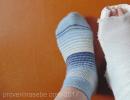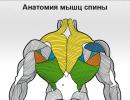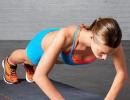5000 kcal per day. Festive overeating. Your weight will increase, but at the expense of water
A festive feast for many is associated with a very big amount not the healthiest food. And the extra 2-3 kilograms the next day is a source of stress and a reason to sit on unloading diet for a week. But what actually happens during a one-time overeating?
You don't gain a lot of fat
During the festive feast, you can eat a lot, but not as much as it seems. We cannot eat endlessly: in response to an unusually large portion of food, the body turns on satiety, and the more food, the greater the feeling of food "at the level of the throat." It is believed that on day X you can eat about 4000-5000 calories, and according to more realistic estimates - about 3500 calories (if you look at a typical holiday table). That is, it is 1500-2000 calories more than a person's weight maintenance norm. At the same time, in order for the body to store a kilogram of fat, you need about 7,000 calories in excess of the norm - thus, you need to eat about 9,000 calories per day.
In addition, studies show that if you eat a lot of food in a short period of time, b O Most of the calories burned will leave the body as heat instead of going to fat, as opposed to eating small amounts evenly over many days.
Carbohydrates
Carbohydrates are energy, and they turn into fat only in extreme cases - with their systematic overeating and exceeding the calorie norm. On average, the body stores between 300 and 500 grams of carbohydrates as glycogen, depending on weight, height, and amount of muscle. If your glycogen stores are partially depleted (for example, you were dieting and/or exercising a lot before the holiday), you can eat several hundred grams of carbohydrates, and almost all of this will be stored as glycogen, not fat. And pay attention: we are not talking about the weight of the finished meal, but about the carbohydrates in it. At the same time, glycogen attracts water, which leads to a temporary increase in weight.

Fats
Unlike carbohydrates, excess fat is easily stored in fat, which is logical. The fate of almost all dietary fats is to replenish fat cells. But if a person maintains a calorie deficit, fat leaves the cells and is used for energy throughout the day. If not, they will stay there. But visually, they still cannot affect the figure in one evening - it is simply impossible to eat so much at a time.
Alcohol
Alcohol is the fourth macronutrient besides proteins, fats and carbohydrates. Ethanol is a poison for the body, so the body will first break it down and use the energy released in the process. At this time, the oxidation of fats and other fuel sources is inhibited, and they replenish fat stores more easily. A Alcohol also increases appetite and reduces self-control in eating.
Your weight will increase, but at the expense of water

You wake up the next day feeling heavy and swollen. Weigh yourself and see +3 kg on the scales. You don’t need to drive yourself to the gym and work off what you eat, you don’t need to starve for a week, because it’s not fat. There are a few things that add weight and volume to the body, but are not fat.: weight of food in the gastrointestinal tract, swelling from a large amount of salt in the festive food and glycogen along with the water it retains. All thisadds from a few hundred grams to a couple of kilograms, which will go away in a few days, as soon as you return to your usual diet.
- Plan to raise calories to maintain weight
Losing weight on holidays is a bold and impossible decision. A much more realistic and workable strategy is to switch to calorie maintenance to maintain your weight. 2000 calories instead of 1500 calories is a more pleasant figure in terms of the amount of food, and at the same time it helps psychologically: you eat more, but do not break the plan and do not suffer from guilt. - Schedule strength training.
If you are into fitness, go for strength training on the day of the feast or the day before: physical activity creates a state of better absorption of nutrients in the body. - Plan your meals for the day.
Many make a big mistake and deliberately starve during the day before the feast. As a result, in the evening they are so hungry that they begin to eat uncontrollably a lot, and then feel bad - both mentally and physically. Instead, eat lean protein and vegetables for breakfast and lunch on Day X. So you make room for calories, which at feasts always come from fatty and carbohydrate foods. - Controlling the quantity of food or its quality.
For different people different strategies can work: it’s easier for someone to try everything, but a little bit. Someone - choose a few more or less dietary dishes and eat only them.
Even on the festive table you can always find something from healthy eating: vegetables, meat, fruits. Half the contents of your plate should be protein (turkey, lean pork, beef, fish, poultry). The rest is vegetables in any form and a little "harmful" (fatty cheeses, sausages, sauces, desserts). - Limit sugary drinks.
Sugary drinks are a source of empty calories. - Less drama.
If you could not resist and overate, there is no point in scolding yourself - on holidays and feasts it is normal to eat not the most healthy food. However, if you go on a food "binge" for weeks and months after the holidays, if you wait for them to eat properly "forbidden", this is a sign that something is not right with your diet. Perhaps the rest of the time you eat too little, limiting your food and food choices too much. Hungry times with the grand opening of a can of red caviar and a festive servelat are in the past, and every person can buy whatever he wants at any time and eat it in moderation.
conclusions
- One-time overeating does not make you fatter.
- Holidays and feasts increase weight due to edema, not fat.
- Not all overeating is unhealthy. If you are sitting on strict diet, periodic increase in calories at the expense of carbohydrates can be for metabolism.
- It's okay to relax a little on holidays. The main thing is not what you do occasionally, but what you do most of the time. If 80% of the time you are on a diet, then the other 20% is not so important.
Kilo calories, commonly referred to as calories, are units of energy in food to fuel your body. You and your doctor may have decided that you need to consume 5,000 calories a day for a variety of reasons, such as weight gain or the promotion of an intense exercise regimen. At first, you may not know how to eat 5,000 healthy calories every day, but with some practice, you can successfully eat nutritious, delicious meals with the calories you need.
Video of the day
Step 1
Eat six meals of approximately 833 calories each. According to Basic Nutrition and Diet Therapy, it's best for your metabolism and digestion to consume six meals a day, as opposed to the traditional three.
Step 2
Plan your meals well in advance so that you have approximately 833 calories in each meal. Use a calorie counter or an online resource to look up calories for foods you are unfamiliar with.
Step 3
Include lean protein, vegetables, and complex carbohydrates with every meal. Protein, vegetables and whole grains are the cornerstone of a healthy diet and you should include meat, fish and tofu in your diet to meet your lean protein needs, a wide range of vegetables such as lettuce, peppers and squash for your vegetables and a variety of whole grains such as whole wheat pasta, whole grain bread, brown rice and wild rice to meet your complex carbohydrate needs.
Step 4
Cook with olive oil to add healthy omega fatty acids to your meals and increase calories to help you reach your required 833 calories per meal.
Step 5
Add calories to food by using nutritious, high-calorie foods. For example, enjoy a large avocado that sells 322 calories, 14g fiber, and 975g potassium. Alternatively, bring your salad back with some sunflower seeds or walnuts, which are 165 calories per ounce and 185 calories per ounce, respectively.
Step 6
Avoid sugary and fatty foods such as cookies, cakes, sweets and candies. While this may seem like an ideal and necessary food choice to increase your calorie intake, it's best to choose healthy foods to meet your calorie needs.
We are often told that weight gain and loss follow simple physical equations, determined by the difference between calorie intake and expenditure. In our comments on the site, the expression “elementary physics” occurs with enviable regularity. No wonder: for decades, the official recommendations of nutritionists have been reduced to the fact that you need to “eat less” and move more, and this dogma is firmly imprinted in the mass consciousness. Again, one calorie does not always equal another calorie. We get fat not because we consume too many calories, but because we eat a certain food. Our bodies are not subject to “elementary physics”, but to complex biochemistry and endocrinology.
And although it is very difficult to break existing stereotypes, I will try to do it once again. Here is the wonderful story of a guy named Sam Feltham who set out to debunk the popular myth that “all calories are equal” by example. To do this, he conducted a series of experiments on himself in the best traditions of the film director Morgan Spurlock - the one who ate only at McDonald's for a month and documented the change in his condition and well-being (the film “Double Portion”).
Sam decided to try eating more than 5,000 calories a day for 21 days and see what happens. For those not in the know, the usual recommended intake is approximately 2,500 calories per day, with variations based on gender, height, age, and level. physical activity. Sam calculated his recommended level and came up with a figure of 3,058 calories per day.
Proteins - 22%
Fats - 72%
Carbohydrates - 6%
The proportion, of course, is correct, but only Sam literally ate for two, consuming 2,736 calories more than he spent. Theoretically, based on such an excess of calories, he should have gained at least 7.5 kg in 3 weeks. But practice does not always confirm theory. After 21 days of his epic gluttony (with 400-gram steaks every night!) Sam Feltham weighed only 1.3 kg more than at the beginning of the experiment. But having added a little weight, he also managed to visually lose a little weight: his waist decreased by 3 cm - from 79.5 to 76.5 cm. Measurement of the percentage of body fat showed a figure of 12.6% - almost ideal for an athlete .


Throughout the experiment, Sam led a video blog, here you can watch a video summarizing all 21 days:
The experiment, of course, showed that even while seriously overeating on LCHF, Sam Feltham almost did not gain weight. But maybe it's all about some unique properties of this guy? Maybe he is one of those lucky ones who manages to eat as much as he wants without getting fat, so for "ordinary" people his experience does not matter? To test this claim, Sam ran a second experiment three months later, which he called the "Fake Food Challenge". This time, he got his 5,793 calories from what he called "fake food" - rich, refined carbohydrates, beautifully packaged ready meals.
Here's what his new diet looked like:
Breakfast:
Bran Flakes (100g) Skim Milk (300ml) Strawberry Jam (100g)
Snack 1:
Mini pizza with tomatoes and cheese (500 g) Strawberry yogurt 0% fat (330 g) Can of Coca-Cola (330 ml)
Lunch
Sandwich of 2 slices of whole grain bread and chicken filling with tikka sauce (100 g) Chocolate muffin (105 g)
Snack 2:
Potato chips with cheese and onions (35 g) Reduced fat rice pudding (500 g) Can of Coca-Cola (330 ml)
Dinner
Lasagna with cheese and pepperoni (400 g) Garlic bread (100 g)
Snack 3
Aerated chocolate (150 g) Strawberry yogurt 0% fat (330 g)
Total for the day: 5793 calories, 892.7 g carbohydrates, 188.65 g protein, 140.8 g fat
Proteins - 13.50%
Fats - 22.65%
Carbohydrates - 63.85%
Not an LCHF at all, but absolutely in line with the WHO recommendations for calorie intake from various nutrients.
This time the experiment was not so successful for Sam. Such an active overeating of food rich in carbohydrates and poor in fats gave its results visible to the naked eye:

Bottom line: plus 7.1 kg and as much as 9.25 cm at the waist, which is clearly visible in the photographs. In addition, this time Sam measured the percentage of body fat before and after the experiment. This figure jumped by a third - from 12.6 to 16.9%.
While the number of calories in the two cases was identical, as well as the level physical activity, then we can assume that the experiment convincingly showed that the point is not in the number of calories, but in their source. At least for an English guy named Sam Feltham. This experience hardly meets the strict criteria of serious scientific research, but sometimes the experience of a particular person is more impressive than a lot of articles in specialized peer-reviewed journals.
PS. In order to get rid of the results of experiment number 2, Sam performed experiment number 3 by putting himself on a strict LCHF diet with a total calorie intake of 3,500 calories per day. That's not a lot of calories, but theoretically this is the level of calories that Sam needed to maintain a stable weight at his level of physical activity. But here, too, practice diverged from theory, or rather from generally accepted ideas. During the three weeks of “rehab” on the LCHF of normal calories, Sam lost 5.65 kg and 7.5 cm in waist circumference. The proportion of body fat in his body decreased from 16.9% to 14.2%.


Tumblr 0
Vkontakte 0
print 0
0
whatsapp 0
Continue Reading
You may also like
This entry has 75 comments
Nutrition is an integral part of any training, especially during the build-up period. muscle mass. In the last article, we talked about the super-intensive mass program. Of course, the food here must be special. First, let's look at the main points associated with taking supplements.
- Use creatine. Not only does creatine cause more fluid to be pumped into the muscles, it also enhances the strength of the working muscle by increasing the level of phosphate in muscle tissue. This substance stimulates the production of ATP, which is the main fuel for the life of the muscles. Take 3-5 grams of creatine mixed with protein shake before and after training.
- Accept. This amino acid causes the body to produce a large number of nitric oxide, which increases the lumen between the vessels and promotes blood saturation of all muscle fibers. Take 3-5 grams of arginine in the morning, then half an hour before training and before bed.
- . This substance accelerates recovery and stimulates the production of growth hormone. Also, glutamine helps increase the amount of fluid in the muscles, which increases pumping. Take it should be 5 grams along with arginine.
Before presenting the meal plan itself, consider some important features nutrition during the program on the mass.
- Eat 6 times a day, for this, divide 3500-4000 calories into six meals. The intervals between doses are approximately 2-3 hours. On non-training days, include the seventh meal.
- 30% of the total calories should come from proteins, 50% from carbohydrates and 20% from fats. Try to follow this as clearly as possible. Per kilogram of weight should account for 3 grams of protein and 6 grams of carbohydrates.
- Due to the wild intensity of the training, the total calorie intake is also high. Be sure to take protein and carbohydrates before and after training. This is best for muscle growth.
| Products | calories | Protein | Carbohydrates |
|---|---|---|---|
| Breakfast | |||
| 6 egg whites, 4 yolks | 334 | 33 | 2 |
| 2 cups oatmeal | 300 | 14 | 50 |
| Lunch | |||
| 85 | 20 | 1 | |
| 150 gr milk | 90 | 9 | 9 |
| 1 cup rice | 214 | 6 | 46 |
| Dinner | |||
| 150 gr chicken breasts | 155 | 30 | 0 |
| 4 slices wholemeal bread | 320 | 12 | 60 |
| afternoon tea | |||
| 180 gr cheese | 145 | 23 | 6 |
| 1 boiled potato | 220 | 4 | 50 |
| Before training | |||
| Food substitute cocktail | 390 | 40 | 40 |
| After training | |||
| 1 scoop whey protein | 85 | 20 | 1 |
| 4 slices of white bread | 320 | 9 | 60 |
| 1 banana | 110 | 1 | 28 |
| Dinner | |||
| 250 gr grilled beef | 500 | 48 | 0 |
| 2 boiled potatoes | 440 | 8 | 100 |
| 2 cups broccoli | 100 | 11 | 14 |
| Second dinner | |||
| 1 spoon of casein | 110 | 20 | 2 |
| 1 cup oatmeal (with protein) | 150 | 7 | 25 |
Do not forget that the end result of muscle pumping depends not only on competent training program and genetics, but also on how well the athlete eats. Unsystematic and thoughtless nutrition can nullify any training scheme. Try this diet plan - maybe it will help you too.
We warmly welcome those who no longer know how to dodge, but eat more calories. Well, you, losing weight, also read how people eat.
Often, trying to fit into their KBJU, dinner is made with minimal calories. We did exactly the opposite: we sat, thought and prepared a set of two dishes for as much as 5500 kcal. One of Zozhnik's founders had homemade sesame-butter mayonnaise pork with Robuchon's mashed potatoes for dinner, and a blueberry milkshake with whipped cream for dessert.
Meat

Meat, of course, took the fattest - pork. Well, they didn’t particularly trifle: they took a juicy piece in 330. They sprinkled the meat with spices and thoroughly beat it up with these deft hands of theirs. Then olive oil was poured into a frying pan and this piece of flesh was thoroughly browned. Then they put the meat in a fireproof form on top of rosemary sprigs, and began to make homemade mayonnaise. Yes, not a simple mayonnaise, but on sesame oil (it seemed to us that it would be more sincere). In general, the yolks from the morning omelet finally came in handy. We took one egg yolk, 20 g of wonderful Moutarde au Poivre Vert mustard with green pepper, 50 g of sesame oil and beat the whole thing with a mixer.
They flavored the meat with fragrant mayonnaise, put a couple of slices of tomato (how could it be without fiber?!), and sprinkled Irish cheddar (80g) on top. Then they pulled the foil and put it in the oven, preheated to 220 degrees, until cooked.
Puree

Joel Robuchon is a great chef. He owns 14 restaurants around the world and has won numerous awards and accolades, including three Michelin stars and a total of 25 stars. This is more than any other chef in the world. We had no reason not to believe this man, and we made the puree exactly as he ordered.
We took 1 kg of potatoes and baked it for 2 hours in an oven heated to 180 degrees. Then they took it out, cooled it, cleaned it and rubbed it through a sieve. The mashed potatoes were put in a frying pan and put on the smallest fire. It's time to get 500 g of butter out of the freezer. We cut the butter into cubes, put it on the potatoes and mixed until smooth.
Add 2 yolks to the puree, a pinch of nutmeg and a little pepper. Since the oil was slightly salty, no additional salt was added to the dish. But still, they slightly changed the canonical recipe and added 200 ml of cream with 33% fat content, since the puree turned out to be dryish in our opinion. Sorry Joel!
Cocktail
The milkshake was also made as it should be: for 220 g of vanilla ice cream with boiled condensed milk, they took 100 ml of milk with 6% fat content and 100 ml of cream with 33% fat content. For taste, a handful of frozen blueberries and one large and ripe banana were added. We whipped all this splendor with a blender, and topped it with whipped cream, which we also made ourselves with the help of a mixer and street magic.
Total
While one of us was busy eating freshly cooked food, the other drooled and counted calories. We counted and did not believe our eyes. We recalculated calories on other calculators, checked the labels, compared the coefficients, but the figure remained almost unchanged: 5464 kcal

Even if there is some error in the calculations, then we couldn’t screw up on more than 1000kcal, which means that dinner turned out to be the most caloric. As we planned.
Upd: It turned out that we need to explain why we cooked such food, photographed, ate and wrote the text. “The man-who-ate-it-everything”, and in everyday life the co-founder of Zozhnik Maxim Kuderov, explains:
1. Some people need to eat 4-5 thousand or more calories per day for weight gain. These meals are a big help.
2. It's very tasty. I personally ate it all.
3. It's fun to think and do.
4. It allows people to visually see, understand and be horrified that even one serving of seemingly harmless food can contain an infernal amount of calories.
5. Show off.
6. Make interesting, unique material on Zozhnik.
7. Set a record for the calorie content of one dish.






